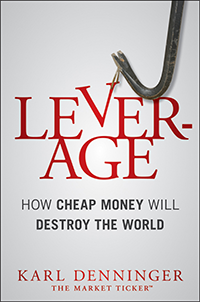In short if you expect rental income flows to remain stable and yet you also think valuations should go up rather than down you're dead wrong.
Here's the simple fact of it: "Cap rate" expresses the return on invested capital as a percentage. A $500,000 property that has net operating income (that is, income minus operating expenses) of $25,000 has a "Cap Rate" of 5%.
What is a reasonable "cap rate"? It is always higher than the short-term interest rate on Treasuries because there is risk in a real estate transaction but there is no risk in short-term Treasuries. That is, if I get a 5% payout on $500,000 worth of 13 week T-bills rolled over every 13 weeks for a year (that is, the IRX is at 5%) for a real estate transaction to make sense it must pay materially higher than that cap rate because I cannot control for the risk that the value of the property may decline, there is significant expense in disposing of the property if I choose to do so and real estate is illiquid (that is, I cannot call someone or get online and get rid of it in a day or three.)
My view has always been that a reasonable minimum cap rate is around 7-8% and I am personally not interested in anything under roughly 10% in real estate because the illiquidity is always there yet it is frequently ignored in terms of the risk profile yet it is in fact the most-extreme problem since it can and does come up at the worst possible and can prevent an exit for six months or more!
There are two ways for cap rate to go up -- the rental can increase or the price of the property can go down. Of course if the latter happens and I already own it I'm the one who is now sitting on a large capital loss -- that's bad. If someone else is sitting on it and I want to buy it that's good.
My general rule for any business transaction is that you don't make money when you sell things -- you always make money when you buy them. This sounds backward but it is not; buying at a good price is always preferrable to trying to figure out how to claw your way out of the hole when you go to sell whatever that thing might be.
People have gotten seriously-intoxicated on the formerly-suppressed rate environment, especially during the 2020-2023 time period. Those days are gone and they're very unlikely to come back in my remaining lifetime. If you expect to see that again within a decade or two I believe you're going to be disappointed at best and are quite-likely to be ruined financially, especially if you are in any way reliant on that.
Buying property to live on is not the same thing as buying property for commercial purpose, whether long-term or short rental or, for that matter, to set up a business on the land itself. Those are very different calculations and one has nothing to do with the other; a home is a consumer durable good, not an investment despite the claims otherwise by many over the last couple of decades. There are a huge number of external factors that can ruin it from an investment perspective (e.g. property taxes shooting the moon) which happen often enough over long periods of time that counting on such is a very bad idea.
Never mind that the "30 year mortgage" never made sense in a world where the average holding time is seven years -- and that latter has been true for decades. Why? Go look at an amortization table; you only pay down 10% of the principal during that seven years. All of the rest of the money went to the bank! It was the insane view over the last two+ decades of price appreciation that made people think this "worked" when in fact it never did because permanent price appreciation in excess of actual realized inflation is mathematically impossible -- the only question is when that will end, not if it will. But the securitizers and security holders (e.g. MBS) all banked on that same seven year duration and now, with rates much higher all the older securitized loans are not prepaying (I wouldn't either if I had one when I have a 3% mortgage but can get 5% in short-term Treasuries with no risk!) so now the worm has turned against said holders. Oops.
In the investment world, including both longer-term "conventional" rental properties and especially the short-term rental world, along with commercial real estate, all this applies and the shorter the term of the rental the greater the risk and thus the greater the cap rate you should and skilled persons will expect because those who overpaid and want to or must sell are sitting on huge capital losses!
Right now there is a severe imbalance in this regard in that cap rates are in many cases below the short-term Treasury rate.
IMHO you'd have to be out of your mind to accept that sort of alleged "return" and thus, at those prices, to be anywhere near that space.

